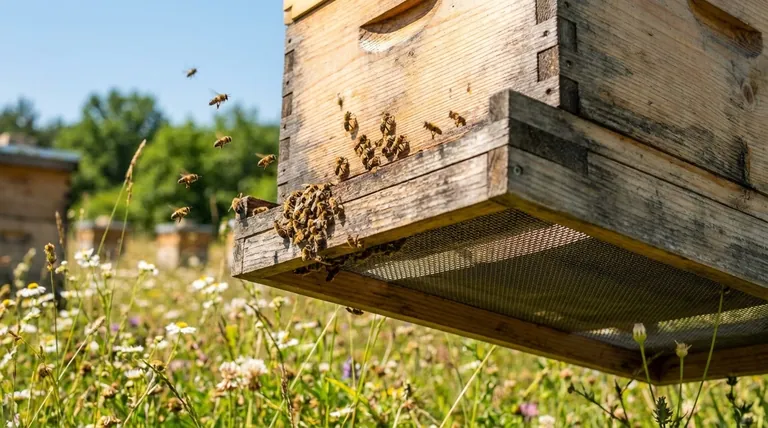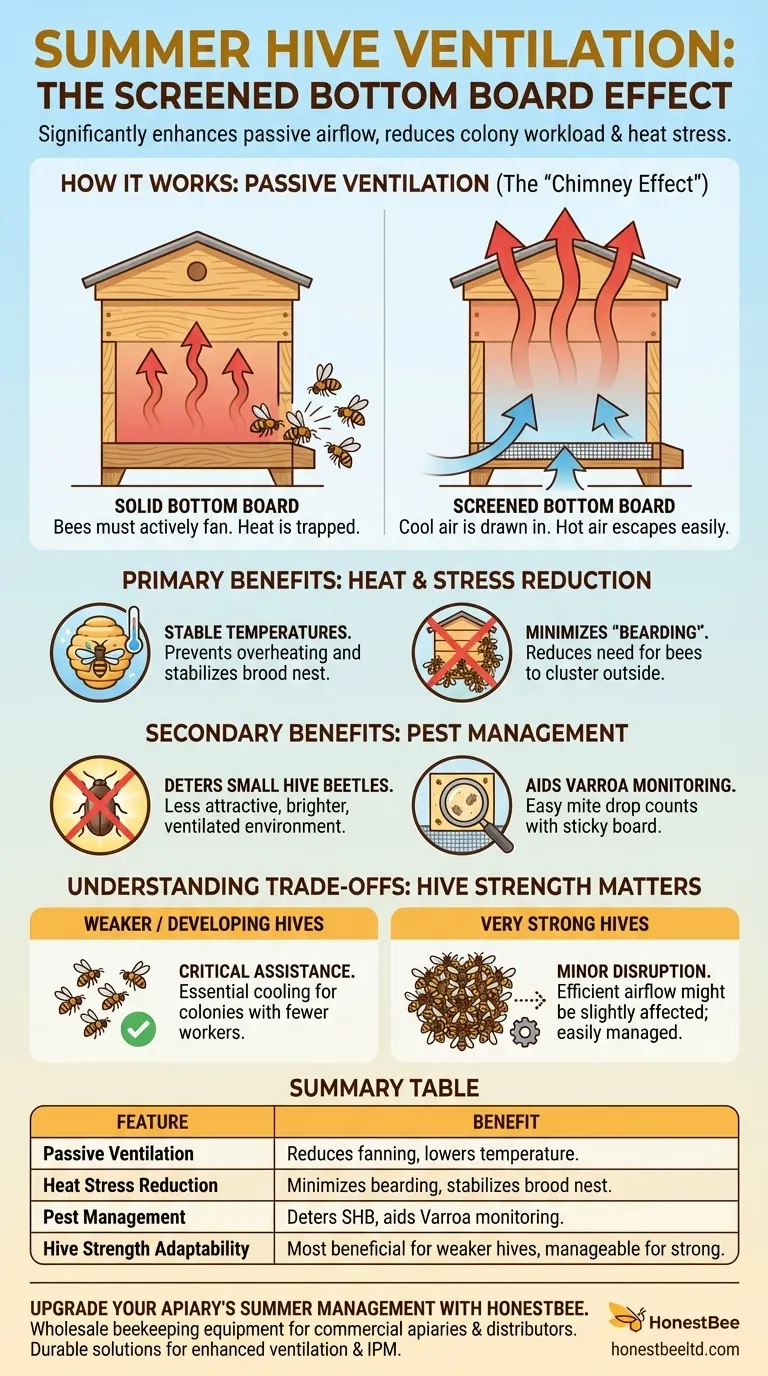In short, screened bottom boards significantly enhance hive ventilation during the summer. They allow hot air to escape and cooler air to be drawn in from below, creating a passive airflow that reduces the colony's workload. This helps the bees maintain a stable internal temperature, preventing overheating and the "bearding" behavior often seen on hot days.
While screened bottom boards provide valuable passive ventilation that reduces heat stress, their true value often lies in secondary benefits like pest management. The decision to use one hinges on balancing the clear advantages against the minor potential for airflow disruption in very strong colonies.

How Screened Bottoms Alter Hive Airflow
A screened bottom board fundamentally changes the physics of your hive, shifting it from a sealed box to a more open, breathable structure. This has direct consequences for temperature and humidity regulation.
The Principle of Passive Ventilation
A solid bottom board forces bees to create all airflow by fanning at the entrance. A screened bottom board allows for passive ventilation, often called the "chimney effect."
As bees work and the sun beats down, hot, moist air inside the hive rises. The screen provides a large, open surface for this warm air to exit, drawing cooler, drier air up from below the hive. This process happens continuously without any effort from the bees.
Reducing Heat Stress and "Bearding"
During intense heat, a colony's top priority is cooling the brood nest. If they cannot manage the internal temperature, bees will exit the hive and cluster on the front, a behavior known as bearding.
By providing an extra cooling mechanism, a screened bottom board makes it easier for bees to keep the hive's core temperature stable. This reduces the need for bearding and allows more bees to focus on foraging and other productive tasks.
The Secondary Benefits of Summer Ventilation
The improved airflow from a screened bottom board does more than just cool the hive. It creates an internal environment that is less favorable for common beehive pests.
A Defense Against Small Hive Beetles (SHB)
Small Hive Beetles thrive in dark, humid, and poorly ventilated spaces. They often lay their eggs in hidden corners of the hive where bees have difficulty patrolling.
A screened bottom board disrupts this environment. It increases light and airflow across the hive floor, making it a far less attractive place for beetles to hide and reproduce. While not a complete solution, it is a significant deterrent.
A Tool for Varroa Mite Monitoring
One of the most powerful uses for a screened bottom board is as part of an Integrated Pest Management (IPM) strategy. By sliding a removable, sticky board under the screen, you can monitor for Varroa mites.
Mites that fall off bees will drop through the screen and get stuck to the board. This allows you to perform a "mite drop count" to accurately assess your hive's infestation level without having to open the hive and disturb the colony.
Understanding the Trade-offs
While generally beneficial, the effect of a screened bottom board is not identical for every hive. Understanding the nuances is key to effective management.
Hive Strength Matters
A screened bottom board provides the most significant ventilation benefit to weaker or developing hives. These smaller colonies have fewer workers available to dedicate to fanning and cooling, so the passive assistance is critical on hot days.
Potential Disruption for Strong Hives
A very strong, populous hive has a large workforce and can create a highly efficient, managed airflow with a standard entrance. In some cases, a fully open bottom screen can slightly disrupt the precise air currents these powerful colonies establish.
However, this disruption is generally considered minor and is often outweighed by the pest management benefits. Many beekeepers use entrance reducers or partially close the screen slot to moderate this effect if it becomes a concern.
Making the Right Choice for Your Apiary
The decision to use a screened bottom board should be based on your specific climate, hive strength, and management goals.
- If your primary focus is supporting a new or weak hive: A screened bottom board is highly recommended to reduce heat stress and give the colony the best chance to thrive.
- If your primary focus is integrated pest management (IPM): A screened bottom is an essential tool for discouraging Small Hive Beetles and, more importantly, for monitoring Varroa mite levels.
- If your primary focus is managing a strong hive in a hot climate: The benefits of passive cooling and pest control almost always make a screened bottom board the superior choice.
Ultimately, a screened bottom board is a versatile tool that shifts the hive environment in favor of the bees, particularly during the challenges of summer.
Summary Table:
| Feature | Benefit |
|---|---|
| Passive Ventilation | Reduces need for bee fanning, lowers hive temperature |
| Heat Stress Reduction | Minimizes bearding, stabilizes brood nest temperature |
| Pest Management | Deters Small Hive Beetles, aids Varroa mite monitoring |
| Hive Strength Adaptability | Most beneficial for weaker hives, manageable for strong colonies |
Upgrade your apiary's summer management with HONESTBEE's screened bottom boards. As a trusted supplier of wholesale beekeeping equipment for commercial apiaries and distributors, we provide durable solutions that enhance hive ventilation, reduce colony stress, and support your Integrated Pest Management (IPM) strategy. Let our equipment help your bees thrive in the heat. Contact HONESTBEE today to discuss your wholesale needs and improve your hive health.
Visual Guide

Related Products
- Langstroth Screen Bottom Board for Beekeeping Wholesale
- Australian Pine Wood Langstroth Screen Bottom Board for Wholesale
- Solid Bottom Board Australian Pine Wood Langstroth Bottom Board for Wholesale
- Langstroth Solid Bottom Board for Beekeeping
- HONESTBEE Advanced Ergonomic Stainless Steel Hive Tool for Beekeeping
People Also Ask
- How does a screened bottom board assist with temperature control and pest management? A Key Tool for Modern Beekeeping
- What are the main benefits of using a Screened Bottom Board in beekeeping? Enhance Hive Health & Productivity
- What are the advantages of a screened bottom board? Boost Hive Health with Superior Ventilation & Pest Control
- How should the screened bottom board be used throughout the year? A Guide for Healthy Hives
- What are the benefits of a screened bottom board? Boost Hive Health & Control Varroa Mites

















